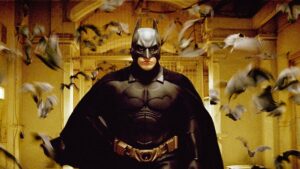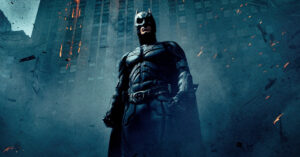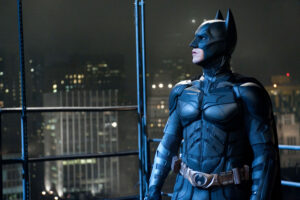“Batman Begins” and Nolan’s Trilogy

Batman Begins
Christopher Nolan’s Batman is a fascinating character and completely different from the comic book hero. The Dark Knight is like the Messiah who is to redeem the iniquities of Gotham.
There is no doubt that Nolan’s trilogy devoted to the Marvel hero is a special, if not outstanding work. Its uniqueness lies in the fact that the director turned the comic book story for children and teenagers into a parable of the contemporary world. Nolan took the story of Batman already firmly rooted in the popular culture, however his films – “Batman Begins” (2005), “The Dark Knight” (2008) and “The Dark Knight Rises” (2012) are not another Marvel movie adaptation. Instead, Nolan activates ancient mythical models, i.e. the figures of the scapegoat and the Messiah, known at least from the Bible.
Batman – savior of Gotham
Nolan’s Batman, played by the phenomenal Christian Bale, is a messianic hero. This means that the construction, history and actions undertaken by this character are stylized as saviors of alternative worlds (known from literature and fantasy films), but most of all they resemble the history of Jesus Christ. The director performs this treatment consciously and clearly. It is worth noting the characteristic division of the Batman stories. The first part of the trilogy, “Batman Begins”, is the genesis of the story of the man-bat, the chosen one, who is to save Gotham from destruction. We are dealing here with the story of Bruce Wayne’s childhood and youth, which from the very beginning are marked by exceptional events. The boy, who survived the trauma of his parents’ death, unexpectedly finds himself in the mysterious League of Shadows, where he is initiated into the secret arcana of martial arts.

The Dark Knight
The training, which the protagonist undergoes in the Far East, is a spiritual initiation and a realization of his power. It may bring to mind Christ’s forty-day retreat in the desert before he began his public teaching. What is more, Bruce Wayne is also tempted. The moment that is supposed to seal his membership in the League of Shadows is an attempt to persuade him to kill a man. However, the man resists and instead of becoming an executor of revenge on the sinful city of Gotham, he decides to stand up for its inhabitants.
Bruce returns to his hometown and, as heir to a fortune, intends to use his resources to create a man-bat, an individual with a hidden identity, who will confront the evil in the city. This is how Wayne becomes Batman, the Dark Knight. He manages to overcome many obstacles on his way, not only Ras al Ghul (Liam Neeson), the leader of the League of Shadows, but also the terrifying Joker (Heath Ledger) in the next part of the trilogy – “The Dark Knight”.
Batman – the biblical “man of sorrows”
Particularly significant for the pronunciation of the entire series is the ending of the second part of the trilogy, in which we are dealing with a prophecy of Batman’s future sufferings and his taking responsibility for the uncommitted guilt. It is delivered by the chief of police, James Gordon (played by Gary Oldman), and his words are a clear paraphrase of the prophecy of Isaiah, who in the Old Testament foretold the coming of Christ and His martyrdom:
“Despised and rejected by men,
A man of sorrows, familiar with suffering,
as one whose face is covered,
so despised that we had nothing to do with him.
But He burdened Himself with our suffering,
He bore our sorrows,
…and we thought of him as a condemned man..,
flogged by God and trampled on”.

The Dark Knight Rises
In this context the title of the third part of the Batman story – “The Dark Knight Rises” – has a symbolic meaning, referring to the death and “resurrection” of Batman as a messianic hero. Indeed, in the film Batman is blamed for all the evil that exists in the city and becomes the scapegoat. Then Bane almost puts the hero to death by breaking his spine (a scene also symbolic), and then takes over the entire city. It is worth noting how precisely the film’s plot transforms biblical motifs. Batman, like Christ, “descends into hell” or is thrown into the dark underworld. Extricating himself from this abyss is an impossible undertaking, but Batman accomplishes what is meant by defeating death, which is resurrection.
Gotham City – a parabola of the world
Gotham City itself also has allegorical features, it can be treated as a metaphor of the modern world. The city is saturated with evil, corruption and lawlessness are rampant everywhere. In the end, the citizens no longer trust even the law enforcement officers. No one can save the world from the final reign of the forces of darkness. Rescue comes at the last moment, and it is the voluntary sacrifice of the messianic hero, Batman. Nolan’s films can thus be read as a parabolic tale about the eternal struggle between good and evil. The latter, however, cannot be defeated by force, but only by selfless sacrifice and love. This is the price for saving the world, says Nolan.

